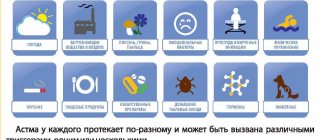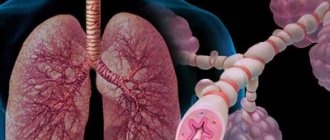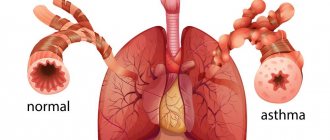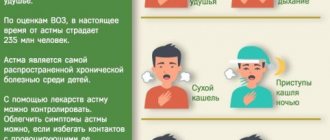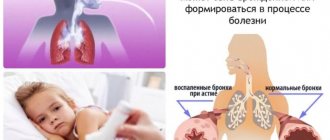Allergic asthma is the most common form of asthma, which is expressed by hypersensitivity of the respiratory system to any allergens.
By inhaling allergen particles, the human body receives a signal about contact with the irritant, and the immune system response is triggered, expressed by contraction of the muscles around the respiratory tract. This process is called bronchospasm. As a result, the muscles become inflamed, and the body secretes quite viscous and thick mucus.
Features of etiology
In February 2020, the International Congress of the Russian Association of Allergists and Clinical Immunologists took place in Moscow, at which the need to make changes to the classical definition of bronchial asthma was voiced. Leading experts are convinced that the disease is heterogeneous. This means that in childhood the dominant phenotype is allergic asthma, which develops against the background of the interaction of environmental conditions and genetic heredity.
In the absence of pathologies, the immune system is designed to protect a person from pathogens, otherwise its natural work is disrupted.
Allergic asthma is an immune response to the introduction of antigens.
When it interacts with IgE (specific immunoglobulin E), the substance histamine is released, causing swelling of the mucous membranes and inflammation of the skin. All this together creates the classic symptoms of allergies: nasal congestion, coughing, sneezing, red watery eyes, spasms in the respiratory tract. This reaction signals the body’s attempts to get rid of the antigen on its own.
Since asthma is a heterogeneous disease, a thorough search for possible allergens is of particular importance. In most cases, attacks of chronic suffocation occur when exposed to animal hair, pollen, fungal and mold spores, and household dust. In medical practice, there are often cases of allergic asthma that develops from light scratches on the skin, frequent inhalation of perfume aromas, caustic household chemicals, and tobacco smoke.
Inhalations
When treating bronchial asthma, special devices designed for inhalation are often used:
- An inhaler is a device that has compact dimensions. Almost all asthmatics carry it with them, as with its help you can quickly stop an attack. Before use, the inhaler must be turned upside down so that the mouthpiece is on the bottom. The patient must insert it into the oral cavity and then press a special valve that delivers the drug in a dosed manner. As soon as the medication enters the patient’s respiratory system, his asthmatic attack is relieved.
- A spacer is a special chamber that must be placed on a container with a medicinal aerosol before use. The patient should initially inject the medication into the spacer and then take a deep breath. If necessary, the patient can put a mask on the camera through which the medication will be inhaled.
Risk factors
In addition to standard antigens, doctors identify other factors that increase the risk of developing the disease. When inhaling cold air, asthmatics experience bronchospasms. This reaction of the body is explained by the fact that at low temperatures it becomes difficult to breathe through the nose. When cold air is inhaled through the throat, drying and narrowing of the mucous membranes occurs.
It is reliably known that during high-intensity training at temperatures below 15°C, allergic bronchial asthma worsens.
Moreover, doctors say that even healthy people in such conditions, without reliable protection, experience breathing difficulties. This does not mean that asthmatics should give up physical activity, but it is necessary to take into account their health characteristics.
The search for true antigens continues in 2020. Based on statistical data, it has been established that since 1990. There is an increase in the incidence of allergic asthma. Many scholars attribute this to a steady increase in demographic change (urban expansion). Air pollution indoors and in the atmosphere adversely affects the functioning of the cardiovascular and respiratory systems.
The most studied allergens are ozone, nitrogen dioxide gases, and volatile organic compounds.
In 10% of cases, asthma attacks and coughing in asthmatics are provoked by medications: beta-blockers, ACE inhibitors, aspirin and other painkillers. Therefore, when prescribing medications, it is important to warn your doctor about the presence of the disease.
What respiratory diseases are not accepted into the army?
For certain health problems, young people are exempt from military service. There is a list of diseases for which a military ID is issued.
List of ailments associated with the respiratory system:
- Bronchial asthma. Moreover, in case of severe form, a military ID is issued, with category “D” assigned. This means that the man is completely unfit. In case of moderate and mild severity, a “B” ticket is issued - limited validity.
- Chronic offensive runny nose.
- Sinusitis polypous.
- Bronchiectatic disease.
- Dysfunction of the speech apparatus.
- Dysphonia and aphonia.
- Sarcoidosis.
- Sinusitis.
- The young man receives a deferment for temporary illnesses.
Clinical severity
The symptoms of allergic asthma depend on the stage of the pathology. In the initial stages, patients note a squeezing feeling in the chest area, rhinitis and conjunctivitis. The main manifestation of the onset of an attack is swelling of the mucous membranes.
Classic signs of the disease are:
- dyspnea;
- convulsions;
- wheezing in the sternum;
- cough, which in most cases is non-productive, but can sometimes be accompanied by the release of a viscous secretion.
With exacerbation of infectious allergic bronchial asthma, to which people aged 35-40 years are most susceptible, the symptoms are somewhat different from the standard. Attacks of suffocation in adult patients with this diagnosis appear after a viral illness or against the background of a recurrent outbreak of the inflammatory process.
In these situations, the upper respiratory tract is most often affected, resulting in the development of purulent sinusitis and bronchitis. Infectious allergic asthma is often preceded by food or drug poisoning. During shortness of breath, patients experience prolonged coughing attacks with the release of purulent sputum from the bronchi. At the same time, motor activity decreases, inhalations and exhalations become more frequent.
Allergic asthma in children can occur at any age. As medical practice shows, in most cases the disease is disguised as chronic bronchitis. For this reason, it is important to differentiate the pathology and prescribe the correct treatment . When a baby experiences more than 4 episodes of obstructive bronchitis over the course of one year, you need to consult a doctor.
Symptoms of allergic asthma appear exclusively upon contact with an antigen. Depending on what specific trigger causes the shortness of breath and cough, the frequency and duration of the exacerbation varies.
Medical classification of pulmonary pathology
Allergic bronchial asthma is of two types, depending on the root cause of its development.
The atopic form of the disease occurs as a result of inhalation of certain antigens into the body.
In this case, a classic clinical picture is observed: difficulty breathing, dry cough, wheezing.
Infection-dependent asthma appears in the presence of pathogenic microflora and is accompanied by pronounced attacks of suffocation, expectoration of purulent sputum, and abnormalities of the respiratory tract. To avoid further spread of infection, immediate diagnosis and initiation of adequate therapy is necessary.
Based on the standard signs of the disease, in medicine there is the following classification:
- Intermittent and persistent mild bronchial asthma. In the first form, exacerbation attacks occur once a week, and in the second - several times every 7-10 days.
- The middle stage of the disease is characterized by the presence of daily attacks of varying intensity. Such frequent symptoms disrupt the usual way of life and significantly worsen the patient’s condition.
- When severe allergic asthma is diagnosed, asthma attacks can occur up to several times a day, with exacerbation occurring at night. In patients, motor activity decreases and status asthmaticus occurs.
What is bronchitis with an asthmatic component?
The patient suffers from incessant cough and difficulty breathing. If left untreated, it develops into an acute and then a chronic form.
There are two types of origin, with the first being predominant:
Exacerbations occur mainly in spring and autumn.
Symptoms:
- Coughing.
- Dyspnea.
- Whistling and wheezing is heard while breathing.
- Allergic bronchitis involves sneezing and runny nose. There is also a sore throat.
Diagnostic methods
At the first appointment, the doctor collects anamnesis, analyzes the patient’s complaints, and listens to the chest.
To make an accurate diagnosis, the patient must undergo a series of laboratory and instrumental studies:
| Diagnostic method | Effectiveness of the procedure |
| ECG | Allows you to exclude the cardiac form of bronchial asthma |
| Spirometry | During the examination, the doctor assesses the patient’s lung parameters and forced expiratory volume |
| Sputum analysis | The presence of Cushman spirals and Charcot-Leyden crystals and eosinophils in the expectorant viscous secretion indicates the development of allergic type bronchial asthma |
| UAC | Elevated values of red blood cells and hemoglobin indicate respiratory failure |
| Blood biochemistry | In asthmatics, laboratory test results will reveal high concentrations of seromucoids, fibrinogens, and sialic acids |
| Allergy analysis | Carried out to determine specific immunoglobulin E |
| Skin tests | Identify potential antigens |
| Food diagnostics | Consists of keeping a food diary, provocative diets, differential fasting |
Therapy tactics
The symptoms and treatment experienced during asthma are inextricably linked. After identifying the allergen that provokes attacks of dry cough and choking, an individual treatment plan is drawn up. Standard therapy for atopic or infection-related asthma is based on the following medications:
- Cromones are medications that affect the level of histamine produced. They are actively prescribed for the treatment of childhood asthma, since their use in adults does not lead to positive dynamics.
- Methylxanthines – theophylline, caffeine and theobromine. In recent years, drugs in this group have lost popularity due to possible severe adverse reactions.
- Immunoglobulin E antagonists effectively relieve bronchial hypersensitivity.
- Inhaled glucocorticoids and adrenoreceptor blockers act as basic medications that control the course of allergic asthma. This method of treatment is preferred due to the ease of use of a special device that allows you to quickly respond when an attack of suffocation begins.
- Taking antihistamines blocks neural receptors and reduces the intensity of an asthmatic attack. Doctors recommend taking medications that suppress the production of histamine in advance if contact with the antigen cannot be avoided.
Allergen-specific immunotherapy (ASIT) is becoming increasingly popular. To do this, the patient is administered small doses of a substance to which a violent reaction of the bronchi occurs. Gradually, the clinical severity of asthma decreases or stops. It is important to remember that bronchodilators suppress asthma attacks, but lead to drug dependence.
If the dosage is exceeded, there is a high probability of developing a paradoxical reaction, when symptoms intensify after taking the medication.
Pathogenesis
The effect of an allergic agent on the human respiratory system
The mechanism of allergic asthma is poorly understood. However, scientists believe that the reaction of the bronchi to an allergen is due to the body's immediate hypersensitivity. The mechanism is manifested by the following algorithm:
- the allergen comes into contact with a person, which leads to the synthesis of active substances that cause inflammation;
- due to the increased sensitivity of bronchial receptors, spasm of the bronchial muscles occurs, their lumen decreases, breathing is impaired, shortness of breath and symptoms of suffocation appear.
The stages of the pathological process occur very quickly, the patient’s condition instantly worsens. Shortness of breath can develop within a few minutes after exposure to the allergen. Patients with atopic asthma experience sensitization (that is, sensitivity) to the allergen.
First aid for asthma attacks
Asthmatics should always carry a bronchodilator inhaler prescribed by their doctor. First of all, you need to remember the need to provide access to fresh air by opening a window or door to the room.
Antihistamines or hormonal drugs will help suppress an attack that occurs when interacting with an allergen. You need to try not to panic and ensure maximum comfort: take a comfortable position, remove excess constricting clothing. It is easier for asthmatics to cope with debilitating bronchospasms by sitting with a tilt on the back of a chair or transferring the weight of their own body to their arms.
Patients suffering from an allergic form of asthma should know the technique of proper abdominal breathing, which involves the diaphragm. When you inhale, the muscular partition between the abdomen and chest contracts and falls, and when you exhale, it rises. Due to this, more air enters the lungs, and the blood is better saturated with oxygen. Mastery of abdominal breathing techniques can reduce attacks of asthmatic suffocation.
Massaging the chest in the area of the heart with a warm towel helps. Doctors warn that this can only be done in the absence of a pulmonary disease. When the attack of allergic asthma subsides, you need to give the patient warm tea and milk. It should be understood that all these measures help only with the onset of attacks of mild intensity and in the future you will need to contact an allergist or immunologist in order to find out how to treat asthma in each specific case.
A complication of the disease is the state of asthmatic status, when the patient can exhale air and is resistant to medications. This form of suffocation begins with a slight confusion of consciousness, while the general state of health deteriorates significantly. In the absence of adequate drug intervention, status asthmaticus leads to disability and, in some cases, death.
Allergies turning into asthma

Most doctors come to the conclusion that the precursor of asthma is allergies .
Allergic reactions are a specific reaction of the immune system of a particular organism to substances that are common to most people. The immune system reacts to these substances as an aggressor and produces antibodies, as a result we see allergic reactions. What to do to reduce allergic attacks and not turn into asthmatic ones.
Train or strengthen your immune system . Hardening works best for allergies.
The main thing here is systematicity and consistency. Do not forget that hardening occurs at a temperature contrast. Start small and take your time.
2. Cleanse your body of waste and toxins. Give preference to developing healthy habits rather than bad habits; eat more fiber (fruits, vegetables, bran, whole cereals); monitor timely bowel movements (stool with normal nutrition - at least 2 times a day); Go to bed no later than 12 pm and try not to eat for at least 3 hours before bed. After an illness or a course of antibacterial drugs, be sure to take probiotics for at least 3 weeks in a row.
3. Watch the quality of the food you eat. You need to eat freshly prepared meals from fresh ingredients. Do not eat canned foods, limit sweet and salty foods to a minimum (try replacing sugar with fructose and honey), and slightly undersalt your everyday foods.
4. Drink more clean water (not tea, juice or coffee). An adult should drink at least 2 liters of water per day. It is better to add pieces of ice to the water - the water will become healthier.
5. Do breathing exercises - this will help you use more oxygen from the surrounding air and strengthen your internal organs.
6. Watch your posture . Shoulders should be turned back. If this fails, try walking for several days in a special soft rubber brace, this will allow you to develop the correct habit of healthy posture.
7. Every year in September and March, conduct courses of antiparasitic drugs, it is better if these are plant substances (garlic, black walnut, pumpkin seeds, cloves - have antiparasitic properties).
8. Keep your skin and mucous membranes clean. For hygiene, use detergents without SLS (sodium lauryl sulfate ) - this substance tends to accumulate in the body. For hygiene, do not use creams or gels containing mineral oils . Mineral oil is a petrochemical product, used in car engines, but in humans it seals the surface of the skin, causes irritation, and interrupts natural moisture and gas exchange. Mineral oil in children's cosmetics is especially dangerous, because... Children's skin is very sensitive.
9. The air in the room where a person spends most of his time also needs to be purified , and during the heating season, humidity readings need to be monitored. For an allergy sufferer, the humidity in the room at a temperature of 22-24 degrees C should be in the range of 40-55% . An ideal solution for an allergy sufferer would be an air purifier-humidifier or air washer .
Air washers use water instead of a filter. Water can wash out most of the toxins and suspended matter from the air, rid the air of allergens and add the necessary amount of moisture without waterlogging. We highly recommend that you pay attention to environmentally friendly and high-quality Venta air washers; quality and guarantees can be found on the website: www.dk.ru
And lastly and most importantly: try to maintain a positive attitude, smile more often and you will succeed!
If you have any questions, you can contact our specialists by phone: ( 812)716-01-77 or (812)963-44-19. We will be happy to help you .
The onset of each season brings something different to which a person may be allergic. Spring and summer are especially dangerous, when there are so many flowering plants and dust. The body's reaction to them is very unpleasant, and sometimes even unpredictable. Let's talk about what allergies and asthma are, how to properly recover from these diseases, and how effective asthma health courses are in combating this disease.
Non-drug treatment
Doctors emphasize that the allergic component makes the disease unstable, and asthmatic attacks occur suddenly. Therefore, it is possible to completely cure the pathology by adhering to medical prescriptions regarding the dosage and list of medications taken.
Non-drug therapy is of great importance, which consists in reducing the intensity of the impact of antigens on the body.
To this end, the following principles must be adhered to:
- if you have a food allergy, you need to create a dietary plan;
- avoid contact with pets, whose fur acts as an antigen for a patient with bronchial asthma;
- be sure to wear a mask when trees are flowering if you have a negative reaction to pollen;
- If you are allergic to household dust, you need to remove soft toys and fleecy carpets from the room.
Measures are aimed at preventing the occurrence of bronchial asthma

Of course, it is possible to prevent the disease, but there is no 100% guarantee that it will not appear. This is explained by the fact that an allergic reaction can manifest itself quite unexpectedly, but by following some recommendations you can still reduce the risk of its occurrence. Necessary:
- regularly ventilate rooms;
- if there is a tendency to develop allergies, take antihistamines in advance;
- lead a healthy lifestyle and give up bad habits, especially smoking;
- ensure that nutrition is complete and balanced;
- Regularly engage in moderate physical activity.
To summarize, it should be noted that although asthma is considered a disease that has a severe course, with timely diagnosis and treatment, you can successfully get rid of it. All you need to do is be patient and not lose hope for a positive result.

